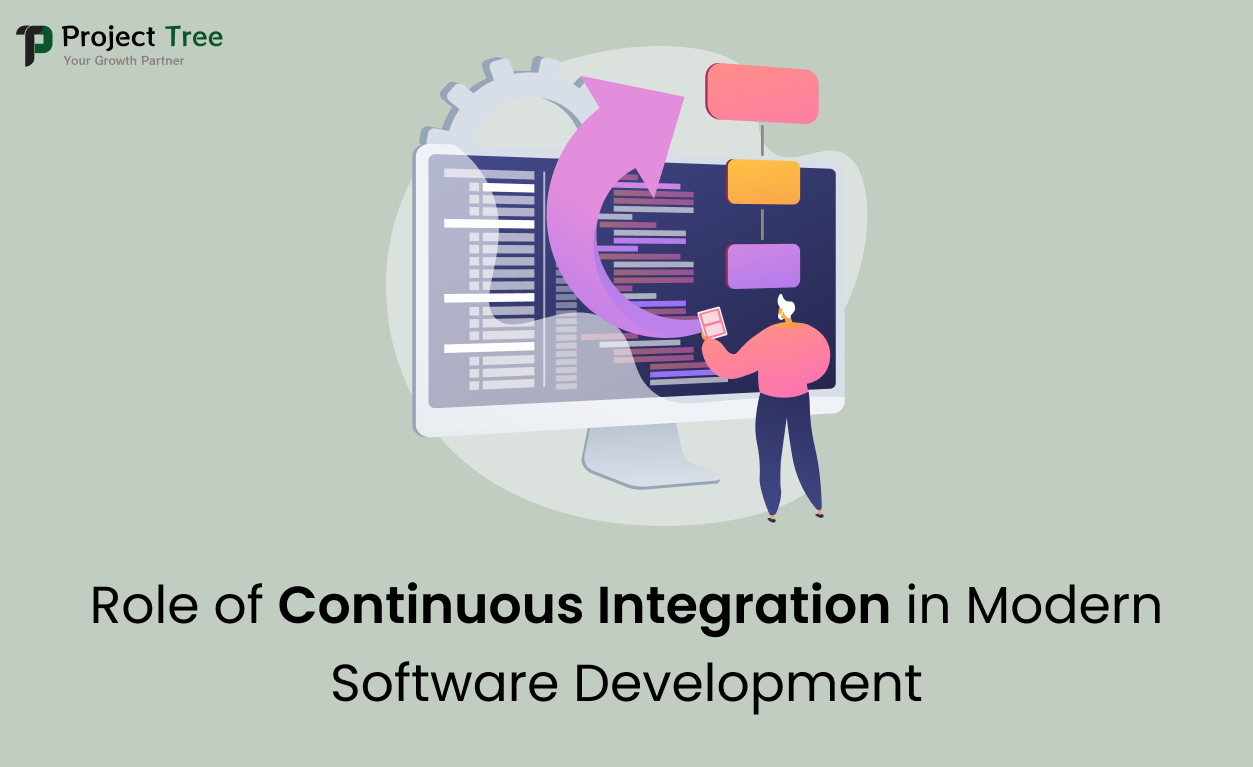In the modern software development world that is now the world of software production, speed as well as quality matter a lot. This is because as the need for faster product releases rises, development teams are under pressure to deliver a more reliable application. It is where ‘Continuous Integration’, better known as CI, plays a vital role. CI is a common practice in modern software development that allows integrating teams to combine code changes more often, build the software using tests, and detect integration problems promptly. CI has now evolved into a fundamental best practice in the development pipelines, largely due to the ability to enable these frequent and automatic integrations of code into a central repository.
Understanding Continuous Integration
Continuous Integration can be defined as the integration of code from multiple contributors to a single project repository more frequently than once a day. This integration often guarantees that a piece of code is tested more often; hence, the possibility of encountering crucial errors down the development phase is minimal. CI advocates the use of automation to an extent as it applies various stages such as testing and building.
Ideally, when the developer is done with a given chunk of code, he/she checks it into a central version control system. This commit in the CI setup means that after this code compilation process, several tests are carried out. In case the build or any of the tests fail, the developer is informed, enabling him or her to fix the defects without delay. This practice helps in avoiding compound formations wherein one forms into the other and may be difficult to diagnose and rectify.
Key Components of Continuous Integration
1. Version Control System (VCS):
The basis of continuous integration is a system for version control like Git. It enables developers to work together on the same project, monitor changes as time passes, and manage code versions. CI processes can keep updated on changes to the custom software development constantly with the help of a common repository.
2. Automated Builds:
An automated process builds the app each time code has been committed to guarantee the connection is successful. The developer is alerted if the compilation is unsuccessful; thus, problems are found immediately. To handle these responsibilities, automation tools like Travis CI, CircleCI, and Jenkins are frequently used.
3. Automated Testing:

The automated test suite is one of the most essential elements of continuous integration. Automatic tests give confidence that changes to the source code do not impact already-existing features. As parts of the Continuous Integration (CI) manage, unite, integrate, and on occasion complete tests take place. Early error detection makes repairs less expensive and easier.
4. Build Notifications and Reports:
In CI, input is essential. The modern software development team gets warnings and data after every build. These notifications help make sure that programmers remain updated about the present condition of a build and can react with immediate action in the case of a problem.
5. Continuous Feedback Loop:
The main benefit of CI is its more rapid feedback cycle. Early identification of problems enables technicians to react to issues and reduce the length of time and cost involved in solving problems. This constant feedback-gathering, evaluation, and programming cycle supports agile development methods.
Advantages of Continuous Integration
1. Early Detection of Errors:
Quick issue discovery is one of the primary benefits of continuous implementation. Traditional approaches to development often resulted in major problems and delays because they integrated and evaluated code only after the cycle. In contrast, continuous implementation (CI) detects issues early on, enabling simpler and more rapid maintenance.
2. Improved Collaboration:
Every developer collaborates on the same codebase in a continuous integration (CI) environment. This method lessens the possibility of merge conflicts, which happen when several modifications are combined and lead to mistakes. Instead of concentrating as much on handling conflicts, developers can write more code.
3. Faster Release Cycles:
Modern Software development is frequently in a deployed scenario because continuous enhancement (CI) encourages regular inclusion and testing. As such, phases of release may be reduced, allowing companies to provide features quicker. Sustaining competitiveness in the constantly changing digital environment of nowadays calls for doing this.
4. Higher Code Quality:
Techniques for continuous development lead to fewer flaws making their way into production and better code. Code quality is constantly checked by software testing, forming the basis for continuous integration (CI). It ensures that only stable, working code progresses throughout the development process.
5. Reduced Manual Errors:
Continuous Integration (CI) reduces the risk of human error by automating routine tasks like deployment and testing. In addition to speeding the procedure, automation ensures accuracy across developing jobs, which could otherwise change when performed manually.
CI and DevOps: A Strong Partnership
Integrating continuous integration (CI) with development and operations teams (DevOps) is a broader strategy aimed at improving efficiency and creating better modern software development. By connecting the gap between development and deployment spaces, CI, or continuous integration, is crucial in a DevOps setting. While existing DevOps techniques like Continuous Delivery, or CD, and Continuous Deployment take charge of the production side, Continuous Integration (CI) makes certain that the software is continually in a usable form.
DevOps requires quick steps, which CI provides the foundations for. Workers can be sure that their changes will not affect the application because each code commit has been verified and merged. This confidence results in more rapid and dependable delivery of software if linked with automated installation processes.
Continuous Integration Tools
Many tools for continuous integration have become favorable over time, each having unique benefits. Among the most frequently employed CI tools are:
1. Jenkins:
A popular free continuous development tool is Jenkins. due to its broad customization abilities and thousands of plugins, it can be used in an extensive selection of creation contexts and integrated with various applications and systems.
2. Travis CI:
A growing popularity is based on the cloud continuous development (CI) service for open-source projects called Travis CI. This is frequently utilized for automating the creation and test steps within continuous improvement pipelines (CI) and offers a smooth connection with GitHub.
3. CircleCI:
Organizations that value efficiency tend to choose CircleCI due to its track record for quick deployments. Capability for Docker-based build is provided, and this is crucial in arrangements that employ containers.
4. GitLab CI/CD:
Using GitLab’s completely integrated CI/CD pipeline, managing the modern software development production cycle from source committed to deployment to production is easy. Organizations that already use GitLab for managing versions are going to find it extremely useful.
5. Azure Pipelines:
CI and CD are supported by Azure Pipelines, an element that makes up the Azure development operations box that provides teams working inside Microsoft Azure with full management of pipelines.
Challenges and Best Practices
At Projecttree, although CI offers numerous benefits, some challenges must be overcome in its effective use. These involve developing the facilities, taking charge of irregular evaluations, as well as making sure every requirement is completed. Lack of preparation may transform continuous integration (CI) into an obstacle instead of an enabler of faster advancement.
While adopting CI, keep these essentials forefront for maximum achievement:
1. Start Small:
A team should start small and build up slowly if they’re new with continuous development. When moving with more intricate builds and connections, begin by automating basic tasks like testing units.
2. Maintain a Fast Build Process:
CI depends on frequent builds. A slow build procedure could end up in constraints. Try to maintain the construction period under 10 minutes to ensure coders can get input fast.
3. Invest in Reliable Tests:
CI centres on test automation. But without consistency, passing or failing tests, or unreliable examinations, could damage faith within the ongoing integration system. Check that your evaluation sets are reliable.
4. Ensure High Test Coverage:
Although speed is essential, scope cannot be lost. Device, unity, and acceptance exams are vital parts of full test suites to verify various facets of the codebase.
5. Monitor and Optimize:
Quality must be constantly evaluated and enhanced in CI processes. The supply chain may be continually evaluated and boosted to get rid of inefficiency and adapt to shifting requirements for the project.
Future of Continuous Integration
The growth of CI is closely connected with developments in the cloud, AI, and artificial intelligence. Already, more intelligent continuous integration (CI) systems use AI-driven data to forecast build failures or recommend enhanced processes. Furthermore, continuous integration (CI) techniques are developing to manage increasingly complicated distributed systems as microservices and cloud-native architectures become more widely used. Building, testing, and deploying containerized apps is becoming simpler thanks to advancements in continuous integration (CI) driven by Kepler and container orchestration technology.
Conclusion
In short, continuous integration has fundamentally altered the way technology is developed, examined, and deployed. Continuous Integration (CI) enables shorter release phases, improved communication, and better quality of code through promoting regular integration, test automation, and rapid feedback. Continuous Integration (CI) becomes a vital field as the creation of software advances, enabling people to trust in and successfully fulfill the increasing expectations of modern technology production.
At Project Tree, we collaborate with DrPro to create tailored healthcare solutions that optimize clinic operations and patient management
FAQs
1. What is continuous integration?
CI is a sub-process of software development in which incorporation of changes into a common repository is done often by the developers and then subjected to tests to detect integrated problems.
2. It determines why CI is crucial in today’s software development
CI effectively minimizes integration problems, enhances the code quality, and enables the teams to identify and address bugs promptly to enhance the effectiveness of software production.
3. What do you think CI does to the speed of development?
CI helps to develop software by providing quicker feedback on the changes made in the code. This way, automated testing makes it possible for the developers to identify certain problems with the test without having delays in the process.
4. What are some of the tools that are mostly used in performing CI?
Some of the most commonly used CI tools are Jenkins, CircleCI, GitLab CI, and Travis CI, whose functionality is to automate the integration and testing process in software development.
5. Can CI be used in both small and large teams?
Yes, CI is scalable and is good for the larger teams as it is for the small teams. In small teams, it encourages a faster cycling through the development process, and in large teams involving many developers, it helps to ensure that there is a proper integration of different developers.

